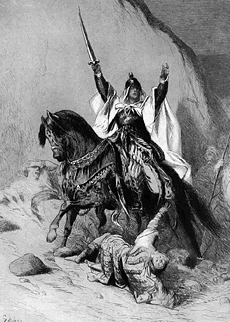Book Review: Saladin, the Muslim Warrior Who Defended His People
History, like much of society, has very few black-and-white episodes. Rather, the history of the world is full of shades of gray. Depending on whom you listen to, an important historical figure is portrayed as either a hero or a villain. Such is certainly the case with Saladin. He is alternately seen as a savior and a sinner, depending on who is doing the talking. One thing everyone can agree on, however, is that he was an important individual. As with all one-named individuals, he had more than one name yet is known by that one name. His real name was Yusuf ibn Ayyub. He was certainly a good Muslim and followed in his father's footsteps. He was also a successful leader, of soldiers and of non-wartime people; and he became known as Al-Malik An-Nasir Salah al-Din. Those in Europe shortened this to Saladin. Saladin lived in the 12th Century, during a time when Islam was flourishing and its warriors were doing battle against Christian soldiers from Europe. One of the prime battlegrounds was Jerusalem, a city that to this day is claimed as a religious center by Christians, Jews, and Muslims. This book does an excellent job of educating the reader on the customs, traditions, and beliefs of Islam. Far from being fanatics who pursue only holy wars, Muslims then and now have their own customs that are by and large peaceful and devotional, centering on their relationship with Allah. English-speaking readers of this book might find the whole scenario unfamiliar, and the author and illustrators work overtime to give as many facts and figures as possible without overwhelming the reader. Particularly helpful is a map showing the varying Muslim peoples and the lands that they controlled during various times.
In his later life, Saladin was first and foremost a warrior. He inherited his uncle's throne and army and set about uniting the Muslim peoples of the Middle East. Once that was achieved, he turned to a larger threat, the increasingly more powerful Christian armies that were bent on recapturing the Holy Land, including Jerusalem. Time after time, Saladin and other Muslim leaders fought against kings and soldiers from all over Europe, storming and sacking castles and towns in a struggle over land that all thought was holy in their name of their religion only. Saladin proved himself a brilliant military tactician. Saladin's best-known enemy was England's King Richard I. The two men fought against each other several times, exchanging victories and territories. Saladin ultimately kept Jerusalem for his people but didn't live long enough to properly enjoy his victory. Saladin was a shining light in the Muslim struggle for supremacy during the Crusades, yet he was so preoccupied with solving the problems of his present that he spared few thoughts for the future of his people. After he died, his people and lands descended into squabbles and chaos. Muslims still fought together, but they lacked the charisma and power of a Saladin. Still, the invading Christians could not convincingly press their advantage, either. Eventually, the Crusades stopped. Saladin's name continues to be mentioned, however, as a leader of his people and a great military leader as well. |
|
Social Studies for Kids
copyright 2002–2024
David White



 Saladin is best known for his military prowess, but he certainly grew up as what Westerners would call a normal child: He went to school, he learned languages and religion, he learned trades, and he did family chores.
Saladin is best known for his military prowess, but he certainly grew up as what Westerners would call a normal child: He went to school, he learned languages and religion, he learned trades, and he did family chores.

